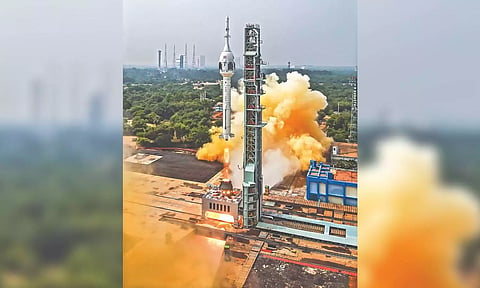

NEW DELHI: The Indian Space Research Organization on Saturday successfully completed its first unmanned test flight, in the run-up to its ambitious human space flight mission Gaganyaan. The test flight was conducted two hours after the launch was initially aborted with barely four seconds to go for the lift-off. Following a system monitoring anomaly and two weather-related holds, ISRO scientists simulated an abort situation for the Crew Escape System (CES) to carry the Crew Module(CM) out of the test vehicle TV-D1.
ISRO’s cutting edge expertise was showcased when the module to test the safety of crew in emergency situations descended using parachutes for a splashdown into the Bay of Bengal with planned precision. The Test Vehicle mission represents a landmark for the Gaganyaan programme as a nearly complete system was integrated for a flight test. This comes close on the heels of the successful soft landing of India’s unmanned moon mission Chandrayaan-3 in August. ISRO is set to return with another unmanned Gaganyaan test vehicle mission early next year. And India plans on sending as many as three astronauts into space on a Low Earth Orbit of 400 km for three days and bringing them safely back to the Earth as part of the Gaganyaan mission likely to be launched in 2025.
The space agency should not be faulted for taking things slow, as human safety is of paramount importance. India’s space programme, compared to Russia’s, is 65 years behind the curve. It was in 1961 that USSR sent its astronaut Yuri Gagarin into space. Almost a decade later, in 1969, the US reset the space race equations by landing Neil Armstrong on the moon.
But not everything works as planned. NASA has launched 166 crewed space flights in its lifetime. Tragically, three of them ended in failure, which led to the deaths of 17 crew members in total. The Apollo 1, which never lifted off, suffered from a cabin fire during a launch rehearsal test in 1967, which ended up killing three crew members. Two decades later, in 1986, STS-51-L mission (the Challenger) experienced a structural failure during its ascent phase 73 seconds after launch. The mission never achieved orbit, and all seven crew members perished. Then in 2003, STS-107 ( Space Shuttle Columbia) disintegrated while re-entering the atmosphere over Texas and Louisiana, killing all seven astronauts on board. Kalpana Chawla, an astronaut and aerospace engineer who was the first woman of Indian origin to fly to space, was among the casualties.
At the risk of sounding didactic, a manned space mission is not an endeavour that any space agency must expedite, either on account of arbitrary political deadlines or in an attempt to catch up with the western powers. The temptation to deliver on a war footing is strong, especially when one considers the likes of private enterprises like Elon Musk’s SpaceX and Jeff Bezos’s Blue Origin, which have already begun flying billionaire tourists into space for the ultimate high.
But, it is unrealistic to expect ISRO alone to shoulder the load of such high expectations. Apart from a significant budgetary boost to the agency, it is imperative that private players are offered the necessary incentives and ecosystem to join India’s space programme, and push it to the stratosphere.